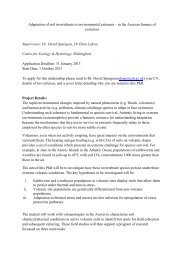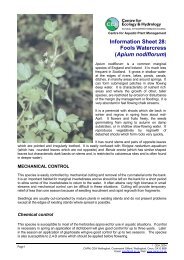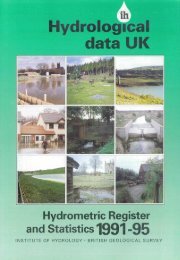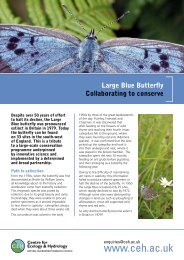ECOFACT Volume 1 Introduction and Approach - Centre for Ecology ...
ECOFACT Volume 1 Introduction and Approach - Centre for Ecology ...
ECOFACT Volume 1 Introduction and Approach - Centre for Ecology ...
You also want an ePaper? Increase the reach of your titles
YUMPU automatically turns print PDFs into web optimized ePapers that Google loves.
Assigning new vegetation plots to classes within the CVS <strong>and</strong> exceptions:<br />
In order to allocate vegetation plots (quadrats or relevèes) to the existing hierarchical<br />
classification, a binary decision tree was constructed. At each node of the tree a decision method<br />
was implemented, appropriate to the classification being emulated. The decisions were based on a<br />
partition of multidimensional species-space. The resulting decision tree produced a deterministic<br />
result, allocating each vegetation plot to a single vegetation class. It should be emphasised that<br />
this procedure gives a precise allocation of each individual plot to the appropriate class of the<br />
CVS, based on the entire in<strong>for</strong>mation available on the species content of that plot.<br />
This structure has been implemented as a software package running under Microsoft WindowsTM.<br />
So far this package has been made available on request <strong>for</strong> testing, <strong>and</strong> has per<strong>for</strong>med well. It is<br />
currently available on the World Wide Web<br />
(http://www.ceh.ac.uk/products/software/CEHSoftware-CVS.htm). This package enables a user<br />
to classify sample plots <strong>for</strong> a variety of objectives.<br />
The classification has also been incorporated into MAVIS (Modular Analysis of Vegetation <strong>and</strong><br />
Interpretation System), a package currently being tested which provides ready access to the<br />
vegetation analysis procedures of CVS, NVC, CSR <strong>and</strong> Ellenberg values. This software allows the<br />
user to enter species lists <strong>for</strong> vegetation units either interactively or in batch mode from a data<br />
file. Once a vegetation unit or units have been allocated to a class or classes, the software allows<br />
the user to determine their positions on the three main vegetation gradients in Great Britain, as<br />
determined from the CVS.<br />
The CVS allocation software provides a means of sorting the different assemblages, using the<br />
whole list of species present. The major exception is saltmarsh, which was excluded from the<br />
analysis as it was represented by only 38 plots <strong>and</strong> is not robustly described within the range of<br />
CVS classes. The five most frequently recorded species were common saltmarsh-grass (Puccinellia<br />
maritima), sea plantain (Plantago maritima), annual sea-blite (Suaeda maritima), sea aster (Aster<br />
tripolium) <strong>and</strong> Spartina spp., but others such as glasswort (Salicornia spp.) may be locally<br />
important. However, if exceptional plots are being observed, eg amongst scrub on sea cliffs,<br />
<strong>and</strong>/or if plots are being examined out of season, then users should be aware that problems could<br />
arise in the allocation.<br />
Tests have been done, e.g. on limestone pavements, where no plots were placed in the r<strong>and</strong>om<br />
survey, <strong>and</strong> the system assigned the list of species to an appropriate group. It is difficult to<br />
provide statistical rules that are easy to apply in order to verify whether a class is appropriate,<br />
<strong>and</strong> judgement must be involved in applying the above guidelines. In critical studies appropriate<br />
statistical analyses should be carried out in order to confirm intuitive interpretation.



![Aquatic bryophytes/lower plants [1.54MB, PDF] - Centre for Ecology ...](https://img.yumpu.com/16155793/1/190x143/aquatic-bryophytes-lower-plants-154mb-pdf-centre-for-ecology-.jpg?quality=85)




